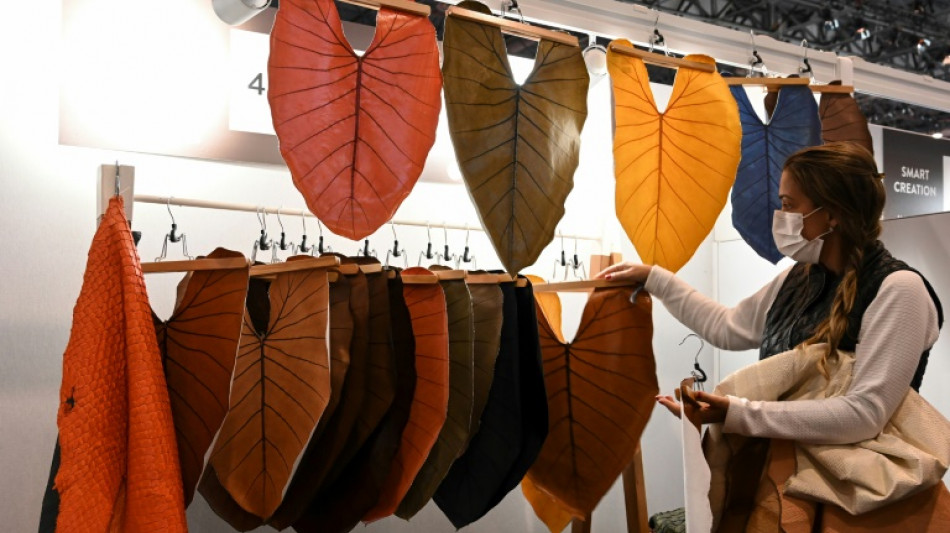
CMSD
0.1900


Sneakers made from banana or pineapple leaves, dresses from nettles or fish scales -- the search for sustainable materials has taken the fashion industry to some wild places.
Experts warn these new textiles are not a quick fix for fashion's enormous problems with over-consumption and waste, but may be a necessary step in developing cleaner technologies.
"You could possibly eat the final product," said Hannes Schoenegger, co-founder of Bananatex, which uses leaves from banana trees in the Philippines to make bags, T-shirts and a line of shoes for H&M that sold out within two hours.
He was speaking at the Premiere Vision Paris conference, where industry professionals gather to find out which fabrics will dominate coming seasons.
"We only harvest the sides of the plants, and they're already growing in the forest, so no chemicals, pesticides or even water are used," Schoenegger added.
He was among multiple stalls presenting new bio-sourced materials.
Brazil-based Nova Kaeru offered leather made from the discarded scales of the giant pirarucu fish and another from the tropical "elephant ear" plant.
Nearby, Ananas Anam showed off some Nike shoes made from waste pineapple leaves.
- Nettles are in -
These textiles can be relatively niche, but some companies are determined to bring them into the mainstream.
Spanish firm Pyratex offers multiple options, from recycling the waste of corn and sugar cane production, to making fibres from Icelandic seaweed, Chinese bamboo or Austrian wood.
"It's not about replacing cotton with one alternative crop. It's about finding a wide variety of substitutes to make sure that nothing is over-used," said spokesperson Pilar Tejada Lopez.
One plant getting particular interest is the nettle, which can be turned into a silk-like and incredibly strong fabric that can be used in everyday and luxury clothing.
It highlights the fact that many of these technologies are not new.
"Nettles have actually been used for clothing for centuries, but we have largely forgotten," said Lopez.
"Part of our job is reintroducing these ideas that have been lost."
- Natural limits -
Others warn of over-reliance on new materials in the drive towards sustainability.
"Replacement materials serve no purpose if we continue to make the same amount of clothing," said Victoire Satto, of The Good Goods, a media firm specialising in responsible fashion.
They could even add to the problem if scaled up by encouraging further deforestation to make way for newly fashionable plants, she said.
That is why companies like Bananatex refuse to go beyond natural farming limits.
"Our project is part of a reforestation programme, a good way of revitalising soils and providing work to local families," said Schoenegger.
"There's a natural limit and we won't go beyond that, because then it would be harmful."
Pyratex similarly puts a lot of emphasis on partnering with responsible farmers, and avoiding the ultra-complex supply chains that make it difficult for clothing companies to know who grows their raw materials and in what conditions.
But Satto says more research is also needed on the durability of bio-sourced materials, since half the ecological damage from an item of clothing is linked to its disposal.
"If the product only lasts six months, that's enormous in terms of environmental impact," she said.
- Iterations -
Ifeanyi Okwuadi, an award-winning British designer, says his focus is on how clothes are made -- not what they are made from.
"When I speak about sustainability, I'm talking about the construction -- right down to using the right stitch-length for each stitch because that kind of minute detail affects the longevity of the garment when you put it in the wash," he said.
He says many bio-sourced materials are still evolving.
"Right now, there's a lot of buzzwords to draw you in, but eventually we won't need to say it's from bananas or whatever -- it will just be plant-based fibres."
"I don't use them in my work because the tech at the moment is quite primitive. But I see them as iterations, like with all technology, and we need these innovations."
B.Chan--ThChM